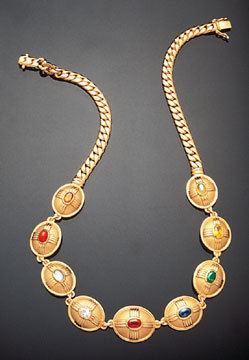 | ||
Navaratna (Sanskrit: नवरत्न) is a Sanskrit compound word meaning "nine gems". Jewellery created in this style has important cultural significance in Hinduism, Jainism, Buddhism, and Sikhism, among other religions.
Contents
Royal setting
The ancient origin of the Nine Gems—called Navaratna in Sanskrit, Hindi, Kannada, Burmese, Indonesian, and Nepali, Navarathinam in Tamil, Navarathnalu in Telugu, Navarathnam in Malayalam, Navaratna in Singhalese, Nawaratna in Malay, and Nawarat or Noppharat in Thai—has proved impossible to trace. Yet such importance is given to this combination of nine gems that they are recognised as sacred and royal in almost all the countries of Asia, including, India, Nepal, Sri Lanka, Singapore, Myanmar, Cambodia, Vietnam, Indonesia, Thailand and Malaysia, regardless of religious and cultural differences.
Recognition in Thailand
In Thailand, the Navaratna is officially recognised as a national and royal symbol of the king. A high award given by the king is called "Noppharat Ratchawaraphon" (the Ancient Auspicious Order of the Nine Gems).
The decoration consists of a single class (Knight). The insignia is:
Gems and planets
Late Thai astrologer Horacharn Thep Sarikabutr has given the meaning of these nine gems in his Parichad-Jataka (chapter 2, verse 21, page 35–36) translated as follows:
"Top quality and flawless ruby is the gem for the Sun, natural pearl for the Moon, red coral for Mars, emerald for Mercury yellow sapphire for Jupiter, diamond for Venus, blue sapphire for Saturn, hessonite for Rahu (ascending lunar node), and cat's eye for Ketu (descending lunar node)."
Further evidence
This quote attributed to the Sanskrit "Brihat Jatak" is also quoted in the "Mani-mala" page 575, verse 79 by S.M. Tagore (1879), and also in the ancient "Jataka Parijata," chap. 2, sloka 21 compiled by Sri Vaidyanatha Dikshitar,
माणिक्यं तरणेः सुजात्यममलं मुक्ताफलं शीतगोः
माहेयस्य च विद्रुमं मरकतं सौम्यस्य गारुत्मतम
देवेज्यस्य च पुष्पराजमसुराचार्यस्य वज्रं शनेः
and reads in Sanskrit transliterated as follows:
maaNikyaM taraNeH sujaatyamamalaM muktaaphalaM shiitagoH
maaheyasya cha vidrumaM marakataM saumyasya gaarutmatama
devejyasya cha puShparaajamasuraachaaryasya vajraM shaneH
Translation:
- Ruby (maaNikyaM) for Surya (taraNeH)(Sun),
- Pearl (muktaaphalaM) for Chandra (Moon),
- Red Coral (vidrumaM) for Mangala (maaheya) (Mars),
- Emerald (marakataM) for Budha (saumya) (Mercury),
- Yellow sapphire (puShparajam) for Bṛhaspati (devejya) (Jupiter),
- Diamond (vajraM) for Shukra (asurachaarya) (Venus),
- Blue sapphire (niilaM) for Shani (Saturn),
- Hessonite (gomeda) or Rahu (the ascending lunar node)
- Cat's Eye (vaidooryaM) for Ketu (the descending lunar node),
...these gems must be high-born and flawless.
Setting arrangement
The traditional setting and arrangement of these nine gems is shown in the illustration. A ruby (representing the Sun) is always in the center, surrounded (clockwise from the top) by a diamond, a natural pearl, red coral, hessonite, a blue sapphire, cat's eye, a yellow sapphire, and an emerald. This is the same placement as the Nava-graha Yantra.
Traditionally, no gem other than a ruby or a red spinel is set in the center of a nine gems arrangement. To do so is believed to go against the flow of nature. Because the Sun is the center of the solar system, its gem is positioned in the heart of a Navaratna Talisman.
For an example of the navaratna in a necklace setting, see Thailand's "The Queen Sirikit Navaratna."
Navaratna gem purity
In the above sloka the words sujatyam-amalam (sujati=high born, and amala=completely pure or flawless) are significant. According to Asian belief systems, only clean, top-quality gems are considered to be auspicious.
In further support of this mostly overlooked dictate, in the Hindu "Garuda Puranam," chapter 68, verse 17, it is stated by narrator Sri Suta Goswami:
" Pure, flawless gems have auspicious powers which can protect one from demons, snakes, poisons, diseases, sinful reactions, and other dangers, while flawed stones have the opposite effect."
And from the ancient " Agni Purana," chapter 246, slokas 7 and 8:
"A gem free from all impurities and radiating its characteristic internal luster should be looked upon as an escort of good luck; a gem which is cracked, fissured, devoid of luster, or appearing rough or sandy, should not be used at all."
Contemporary ideas on gem therapy by Yogananda in Autobiography of a Yogi
"Just as a house can be fitted with a copper rod to absorb the shock of lightning, so the bodily temple can be benefited by various protective measures. Ages ago our yogis discovered that pure metals emit an astral light which is powerfully counteractive to negative pulls of the planets. Subtle electrical and magnetic radiations are constantly circulating in the universe [...] This problem received attention from our rishis; they found helpful not only a combination of metals, but also of plants and most effective of all faultless jewels of not less than two carats. The preventive uses of astrology have seldom been seriously studied outside of India. One little-known fact is that the proper jewels, metals, or plant preparations are valueless unless the required weight is secured, and unless these remedial agents are worn next to the skin."
Gems in sidereal astrology
According to Hindu astrology, life on earth is influenced by the navagrahas, or nine influencers. The placement of the navagrahas in one's horoscope supposedly have an influence throughout an individual's life. Wearing the nine gems is said to provide an astrological balance and benefit to the wearer. Hindu astrology also says that these gems potentially may have both positive or negative influences on human life, and that astrological gems should be worn only after consulting a Vedic astrologer, who is also conversant with gems. Based on an individual's sidereal horoscope, either a single gem or a combination of compatible gems is advised to be worn to harness beneficial planets or counteract harmful planets. The supposed "astrological" or "piezoelectric" benefit of wearing or donating gems has not been scientifically quantified.
